Fires
from a newspaper clipping June 3, 1854
FIRE—Port Hope, once far famed for its numerous and destructive fires, for a long time has been left unscathed by the devastating element, and it was with no small degree of alarm that its inhabitants were aroused from their slumbers on the night of Friday the 2nd inst., by the ringing of the fire bell and loud cries of "Fire," and in about the shortest end of three minutes the "Rescue" Fire Company with their Engine, and the "Arrest" Hook & Ladder Company with their Carriage, together with crowds of people, were proceeding to the scene of alarm near Molson's Mills.
On arriving at the spot it was found that all attempts to save the buildings would be useless, and the companies directed their energies to the protection of the Bridge, the Saw Mill, and some houses in the immediate vicinity of the fire, and by great exertions confined it to the four houses in one block that were burnt.
The building in which the fire was first discovered, was occupied by Thomas Molson, Esq., as a storehouse for empty flour barrels. There is no insurance that we are aware of.
from The Evening Guide Monday July 27, 1959 page 8
FIRES PLAGUE TOWN THROUGH THE YEARS
Fire seemed to plague the town more than now. The town hall, Methodist Church, Barrett’s Mill and Trinity College School all were singed. The blaze at Trinity College School started at the noon hour, on April 24th. Local fire brigade responded to a telephone call, but were unable to give the service from the waterworks pumping station since the School is beyond the town limits. Everything possible was pressed into use and water was carried to the blaze in water pitchers, buckets, pots and kettles. The chemical engine was brought into action, and the Cobourg fire Department were at the GTR station to give assistance by special train if needed.
The origin of the fire was not known, the mystery blaze started in the clothes closet of one of the boys rooms in the top story, and the roof was well under way when the fire was discovered. Everything was hustled from the building and from Dr Bethune’s residence. From the third story to the ground seemed shorter by way of the windows and such things as trunks, pictures and light furniture were tossed out quickly, while books, blankets, bedding were carefully carried downstairs and laid on the grass.
For some time after the fire such articles as boys long underwear, sleeping garments and bedding could be seen swinging from tree limbs where they dangled in the breeze. The loss was about $5,000.
OPERA HOUSE FIRE 1897
Two begrimed and bare looking walls of charred remains enclosing a deplorable looking mass of charred framework are all that remains today of Port Hope Opera House on the corner of John and Walton Streets. The shops and offices immediately underneath are in terrible disorder as a result of the furious fire which raged above on Sunday morning between the hours of 2 and 5 o’clock. The massive structure, the St. Lawrence Hall, next to it, bears evidence of intrusion by an unexpected greedy and destructive visitor.
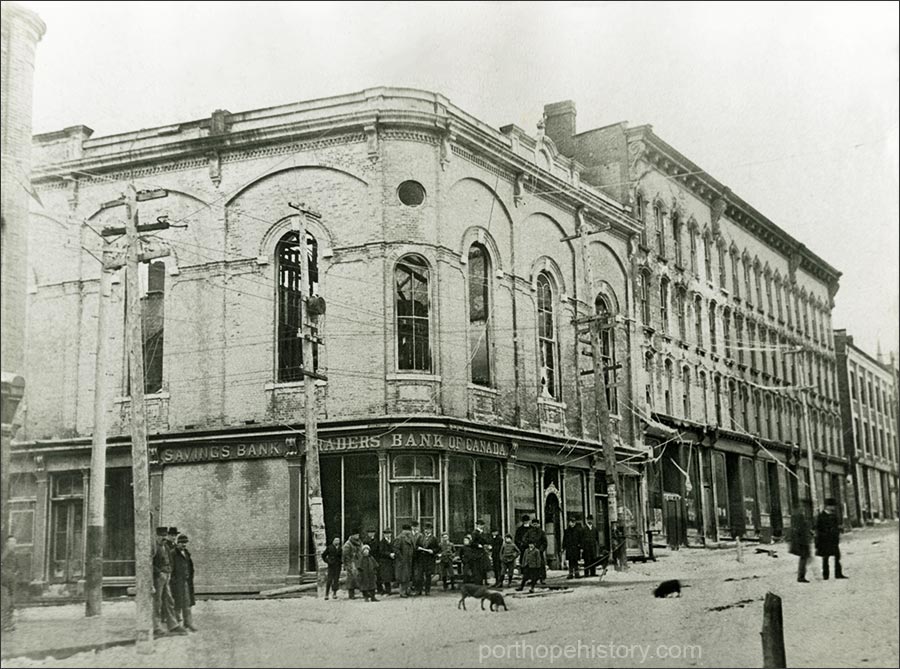
Loss to the Opera House and stores of Jas. Hutchings, butcher; James Reynolds, barbershop; James Hunter wine and liquor dealer; Strong's Billiard parlour, and the Traders Bank is over $20,000. The Opera House was built in 1872 by J. and R. O'Neill. The St. Lawrence Hall (hotel) was built by Hiram Gillett in 1852-53 but he sold it before he had the building completed.
The Opera House continued in service after extensive rebuilding and remodelling. It accomodated road shows and public gatherings and entertainment of all kinds. When the Moving Picture industry invaded the theatre world alterations were made to accomodate this new type of amusement.
The building was finally condemned by the inspections department, and ceased its long years of service on June 1, 1929.
May 11, 1897, T. E. Bradburn of Peterborough owner of the St. Lawrence Hall appealed to Port Hope town council for assurance of sewers being put on Walton St. He desired to rebuild the hotel and did not want to be compelled to close the house as Mr Adams of the Queen's Hotel was forced to do. He was given the assurance.
from an undated newspaper clipping (c1906)
DISASTROUS FIRE
Deyell Block Almost Entirely Ruined—Hamly's Store, C.N.R. Offices, Masonic Rooms Burned To The Ground
McKenny's, Mitchell's, and the Offices of H. A. Ward and Henry White Badly Damaged
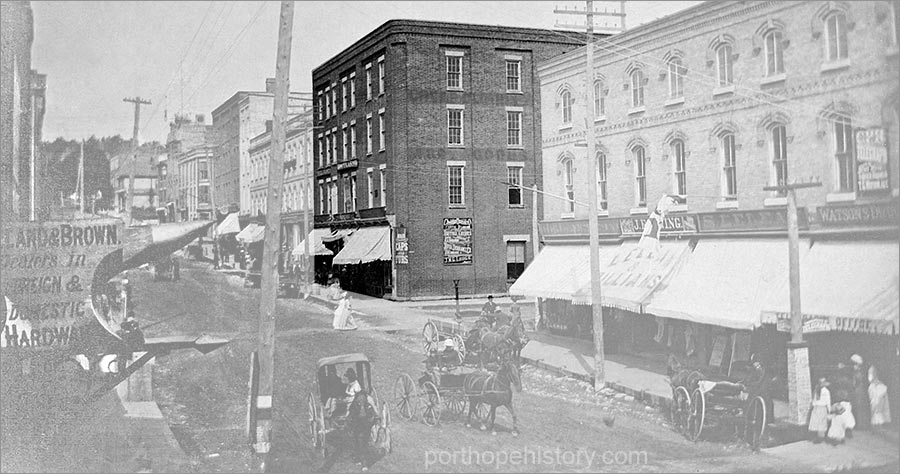
The Deyell block, corner of Walton and Ontario Streets 1878
One of the most serious fires that Port Hope has experienced in years visited the town early last Tuesday morning, and swept out the great portion of the Deyell block, one of the important business centres of the town. The fire started in the basement of
N. L. HamlyNorman Little Hamly
Oct 24, 1870 Port Hope
Dec 2, 1950 Edmonton, Alberta
father Thomas Henry Hamly
mother Mary Margaret Haskill
married Oct 14, 1896 Port Hope
Ida Elizabeth Scott
Aug 28, 1872 Clarke Township
1959 Edmonton, Alberta
father William Scott
mother Margaret J McInteer
's stationery store, and had gained much headway before it was noticed. It was just two o'clock when the alarm was sent in, and by that time the smoke was pouring out of Hamly's store in dense clouds. The firemen were soon on the scene, but their battle with the flames proved a very strenuous one. For a long time the fire was confined to the basement, but it gradually worked its way to the main floor of Hamly's store, thence to the C.N.R. engineers' office, and then to the Masonic rooms, and McKenny's store rooms. The flames shot out from every corner, and about five o'clock the roof ot the building extending from Ben Olver & Co.'s store to the east side of Mitchell's drug store caved in. A call was sent to Cobourg and the brigade arrived on the early train, and rendered splendid service.Oct 24, 1870 Port Hope
Dec 2, 1950 Edmonton, Alberta
father Thomas Henry Hamly
mother Mary Margaret Haskill
married Oct 14, 1896 Port Hope
Ida Elizabeth Scott
Aug 28, 1872 Clarke Township
1959 Edmonton, Alberta
father William Scott
mother Margaret J McInteer
Mr. N. L. Hamly's place is almost completely ruined. The printing press in the back shop is still standing, but all the goods in the front shop are totally destroyed. It is a mass of charred ruins, not a particle being saved. Mr. Hamly's stock was valued at $6,000, with $3,000 of insurance; $2,000 in the Ontario Fire Insurance Co., and $1,000 in another company. Mr. Hamly very unfortunately cancelled $3,000 of his Insurance at the first of the year.
The C.N.R. offices, immediately above Mr. Hamly's store, were completely gutted. The plans, engineers' instruments, furniture, etc., were all destroyed. Fortunately, duplicate plans are filed in Toronto. The loss will be quite heavy with no insurance.
Nothing remains of the beautiful Masonic rooms except a few charred pieces of wood. These new quarters for the Masonic Lodge were fitted out only a few years ago, and were the finest in the Province. The furnishings were of the richest variety, and many ot the decorations cannot be replaced. The loss is estimated at $3,000, with insurance of $2,300, as follows:—Hope and Ontario Lodges, $1,300 in the London Lancashire; Chapter, $500 in the Phoenix; Preceptory, $500 in the Commercial Union.
The furniture in the offices of Mr. Henry White and Mr. H. A. Ward were badly damaged, but their books were only slightly injured, Mr. Ward has an insurance of $1500.
Mr. J. P. McKenny's grocery store is almost a complete loss from water and smoke. The loss is estimated at $3,500 with only a small insurance.
Mr. H. W. Mitchell's drug stock is almost entirely ruined. The water in the store is over a foot deep and everything is completely soaked. The stock which is valued at $10,000 has an insurance of $8,000 divided as follows, $4,000 in Queen City, $2,000 in the Dominion and $2,000 in the Merchants. Ben Olver's stock is slightly damaged by smoke but the loss is covered with insurance.
The block is practically ruined and Mr. Deyell will be quite a heavy loser, his insurance on the building being only $8,000.
Mr. A. J. Vickery, one of the surveyors of the C.N.R., who occupies a room near the Company's office had a very narrow escape. He was awakened by the smoke and managed to grope his way to the phone and send in the alarm. He returned to his room for a grip and his clothing and when he reached the bottom of the stairway he staggered to the street, almost overcome.
The alarm was very faint, only the bell at the Central Hall, and by the way a very useless one, and the Town Hall bell rang. The result was that some of the firemen who have not alarm phones installed in their residences did not turn out, and only a very few of our citizens knew anything about the affair until next morning.
During the progress of the fire quite a heavy explosion took place, caused it is thought by firecrackers and rockets in the Hamly store.
Glass was thrown in all directions and the firemen were driven back so hurriedly that they lost control of the hose and the water had to be shut off.
Business has been suspended in the three stores and the offices above awaiting the arrival of the Inspector.
The origin of the fire is unknown. There was no fire in the furnace.
The block is one of the oldest in town, having been built by the late
Nathaniel WilsonNathaniel Wilson
c1822 Grafton, Ontario
c1865
father David Wilson
mother ? Evans
married 1846
Susan Frances Woodhouse
May 10, 1830 Port Hope
May 26, 1921 Bowmanville, Ont
father David Woodhouse
mother Susan Manning
.c1822 Grafton, Ontario
c1865
father David Wilson
mother ? Evans
married 1846
Susan Frances Woodhouse
May 10, 1830 Port Hope
May 26, 1921 Bowmanville, Ont
father David Woodhouse
mother Susan Manning
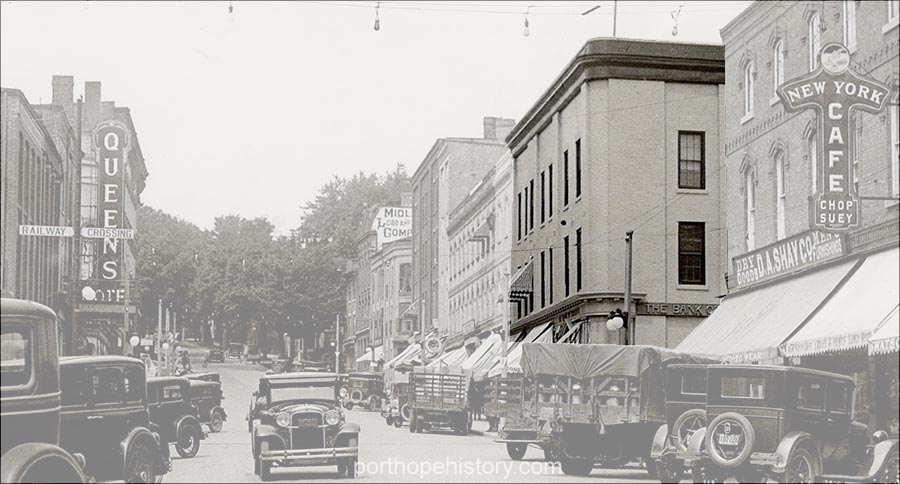
The Deyell block after 1925, minus the fourth storey. The building was torn down, I believe, in 1955.
cursor over or tap the faces
from Port Hope Watchman Friday October 10, 1851 page 2
A letter was read to the Council from Mr. Nathaniel Wilson, dated 20th instant, stating that he would prefer leaving the matter of 'Ontario street' to three disinterested individuals to decide, than to have further litigation, and requesting the Council to stay further proceedings in Chancery.
Moved by Mr. J. S. Smith, seconded by Mr. Ward, That the Committee for opening 'Ontario Street', be instructed to take the necessary steps for arbitrating the difference between Nathaniel Wilson and the Council, as proposed by Nathaniel Wilson, in his letter of the 20th Sept, instant— Carried.
from The Guide Saturday February 19, 1853 page 3
DEBTS CLAIMED FROM THE TOWN COUNCIL
His Worship the Mayor: advanced by him to pay Nathaniel Wilson's claim and costs—£615 s5 d7
from The Guide Saturday November 12, 1853 page 2
Dear Mr. Printer:—
Would you be good enough to ask Mr. Reid, the overseer of Streets, to have the kindness to lay down the side-walk again in front of Mr. Nathaniel Wilson's new building, so that we girls may enjoy our usual walk through the town without the risk of walking ankle deep in mud, or falling headlong over the broken stones and waste timber with which the streets are strewn. The merchants are now all receiving their winter goods, and we wish to have a chance of seeing them before all the nicest things are sold, but really a promenade down street, either for the purpose of shopping, or in the hope of meeting any one in particular, is more than we dare undertake in the present state of the side-walk.
Yours truly,
"The Girls Up Town"
from The Weekly Guide November 13, 1858
PORT HOPE, NOVEMBER 13, 1858
FIRE
Last night, about half past eight o'clock, a fire broke in the stables in the rear of Mr. William Mathews' Hotel, Ontario street. The flames spread with great rapidity, and in fifteen minutes the building, which was old and dry, was a mass of ruins; The Hotel was only separated from the stables by an alley of about twelve or fifteen feet in width, and as might be expected the flames communicated with it. Fortunately, however, the premises are situated close by the creek and an Engine House, and the Rescue Company getting their engine in order in a few minutes poured such a deluge of water upon the Inn, that the blazing cornice and windows were soon extinguished, and the building saved.
Mr. Walker's Cabinet Ware Rooms were in great danger, but the efficiency of the Firemen saved his property from destruction.
A frame House occupied by Mr. Frederick Honor, to the west of the stables was several times on fire,but the engine as often extinguished the flames. The gable was burnt through, and "a lean to" destroyed. Mr. Honor's furniture was removed and of course somewhat injured.
Mr. Mathews has lately built an addition to his Hotel, and raised and otherwise improved the old building. While doing this his furniture was renvoved to the stables in the rear, and up to last night, had not been replaced, and we regret to add, that so rapid was the work of destruction that none of it could be saved. Two horses and a cow were got out with difficulty. Mr. Mathews estimates his loss at $600. The stables were owned by Mr. William Brogdin. The origin of the fire is involved in mystery.
Too much credit cannot be given to the firemen for the energy with which they worked; and too much censure cannot be heaped upon the crowd of lazy, lounging, curious onlookers who, with their hands in their pockets, stared stupidly and indifferently upon the work of destruction—refusing to lead a hand at the brakes to relieve the overworked men who manned the engine. There were many exceptional cases; for instance, Mr. Kirchhoffer, Mr. F. Beamish, Mr. S. Hatton, and gentlemen of that stamp, worked like Trojans; but the great mass of the spectators could not be induced either by entreaties or threats, to do more than gaze open mouthed at the spread of the fiery element.
from a newspaper clipping July 1869
MR. WALKER'S FURNITURE ESTABLISHMENT
Mr. John Walker's Furniture Ware-Rooms and Cabinet Shop, on Ontario St., which have long borne the reputation of being among the best establishments of the kind in this part of the country, have recently been very much enlarged and improved. In addition to the commodious brick building formerly occupied by him, and in place of the old wooden structure in the rear thereof, Mr. Walker this spring erected, in an almost incredible short space of time, a brick wing 23 x 48 and three and a half stories high.
The main building is principally devoted to the display of an almost endless variety of furniture, as is also the second flat above of the new building, while the first flat above of the latter is occupied as a workshop. The ground floor and the half-storey above are at present partially occupied as store rooms.
A glance through the ware-rooms revealed to us a tempting display of really good and substantial furniture, many pieces of which were quoted to us by the obliging proprietor at very moderate prices—sideboards at from $14 to $50, according to the size, kind of stuff and finish; bedroom set-outs complete, of various styles of finish, from $20 to $110; and sofas, lounges, armchairs and other chairs, centre tables, bureaus, book-cases, what-nots, wardrobes, etc., etc., at prices to suit customers. Parties about to make purchases in the furniture line would do well to call upon Mr. Walker, as they will there have a large and well assorted stock from which to make their selections. As Mr. W. keeps some fourteen hands employed, he can manufacture to order on short notice, anything that may be called for in his line.
In connection with his other business, Walker carries on that of Undertaker—a disagreeable, but very necessary office—furnishing a hearse and other requisites when required.
from a newspaper clipping March 22, 1876
BURNING OF THE SKATING RINK
On Wednesday morning last, a little before five o'clock, the north end of the new Skating and Curling Rink was discovered to be on fire, and we regret to add that, through the tardy arrival of the members of the Hose Company, and the most stupid bungling, the building became almost a total wreck.
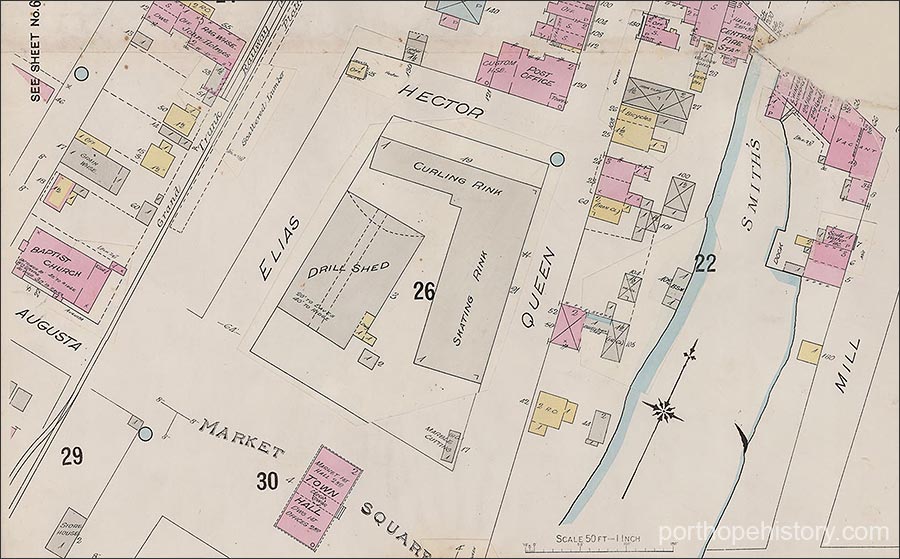
The Skating/Curling Rink was located on Queen Street at Hector Street
Some three or four parties residing in the neighborhood, were early on the spot, but not a single hoseman made his appearance in a reasonable time after the alarm was given, and consequently, though the water works machinery was promptly in motion, the hose was so slow in arriving that little benefit was derived from the works. Capt. Gaudrie, of the Protective Chemical Co., after waiting some time expecting to see the Hose Company dash down at a furious rate, ran up town to learn what was the cause of delay, and found only one solitary member of the Company on hand. Between them they dragged the reel to the fire, and with the assistance of a few citizens, the hose was quickly unwound, and got ready to be attached to the hydrant, when it was found the whole force of the Company represented by one man had no hose-key!
Here was a dilemma that we never knew happen before at a fire, and the assembled multitude sat down, communed with themselves inwardly, and tried to make believe they were breathing on their half-frozen fingers. But in a little while another hose-man arrived who had taken the trouble to unlock his top bureau drawer and get his key before leaving the house, and it did seem even then that the greater part of the building would be saved, for it burned very slowly, when another pause took place, and some of those decent, respectable fellows were profane enough to swear right out loud—and we believe if ever swearing could be justified they had cause enough—for it was found that the hose had been wound up on the reel by the caretaker wrong-end foremost,
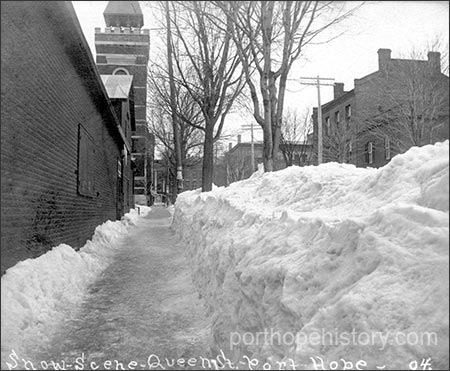 and in consequence it had to be again wound up in order to turn it before it could be attached to the hydrant, and thus more valuable time was wasted.
and in consequence it had to be again wound up in order to turn it before it could be attached to the hydrant, and thus more valuable time was wasted.But at last a stream was got to bear on the fire, when it seemed almost useless to attempt to put it out, the flames having gradually crept nearly all round the building, but the water was used with such good effect that in about ten minutes the fire was under control, and very shortly drowned out, leaving the upright and cross timbers badly charred, but still, we hope, in a sound condition, but whether it is sufficiently good to be used in re-building or not, we cannot say, though we sincerely trust it is.
This fire we hope will prove a warning to the members of the Hose Company and also to the Fire and Water Committee. The former should as a body determine to be promptly on hand when the alarm is sounded, and each man armed with a key—every member should be thoroughly conversant with the method of handling the hose—making couplings, etc.; whilst the latter may very seriously consider the advisability of so increasing the number of hosemen as to be above the necessity of depending upon so limited a number of men in case of emergency, and whether it would not be well to train the members of the Chemical Engine Companies in the use of the hose, so that their services may be available in case of another such difficulty arising through the Hose Company being so dilatory in arriving.
In this case, fortunately, the building was totally isolated, so that there was no danger of the fire spreading, but it looked so dreadfully like there being no necessity for the destruction of the Rink that we were not at all surprised at the indignant exclamations of our citizens as they stood helplessly gazing at the flames as they slowly encircled the entire building, while, if the Hose Company had got to the spot in a reasonable time, very little damage would have been sustained. We trust when necessity again calls the members of the Hose Company from their beds we will be able to give a better account of them.
The Rink was owned by a Joint Stock Company of our citizens. It was built during the present winter, at a cost of about $1,200 and opened about the middle of January. By gross carelessness on the part of some one, it was not insured, and therefore the damage done by the fire is a total loss.
Active measures are being taken to have the Rink re-built at once, and we sincerely trust that the necessary funds will be raised without delay, as it could be turned to excellent account during the summer months as a bath-house and gymnasium. During the short time the Rink was in operation it was well patronized by our citizens, and it promised to be even a paying investment, and it is to be hoped that this serious misfortune will not be allowed to dampen the ardour of our curlers and skaters, to such an extent as to allow the building to stand in its present state very long.
The members of the Curling Club were serious losers, as all the stones, except one pair, were destroyed, together with a large number of pairs of skates, and several flags which had been put on the walls for the carnival held a few evenings before. The cause of the fire is unknown, but from the position of the flames, when first discovered, it is supposed to have been the work of an incendiary.
from the Daily Times 1880
FIRE! FIRE! FIRE!
Seizes on Mr. John Walker's Furniture Factory
And Does Damage to the Extent of $2,000
Misfortunes never come singly.
Last week Mr. John Walker had a valuable horse die, and early this morning his furniture factory (valued with contents at about $8,000), situated on Ontario street and Brogden's Lane, narrowly escaped complete destruction from fire.
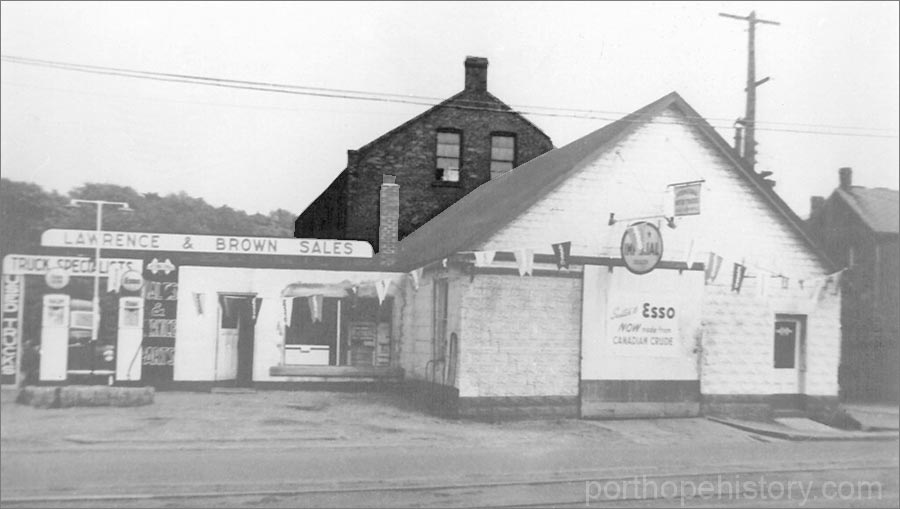
Walker's furniture factory on Brogden's Lane
As near as can be ascertained the fire started somewhere in the neighborhood of the storeroom, immediately above the boiler, at about half-past two o'clock, though some are inclined to think that it must have been smouldering for some considerable time prior to the hour mentioned.
Owing, doubtless, to the closeness of the building and its north end—the worst damaged—being somewhat hidden from the main streets, it was not until about 2:45 that the flames were first seen.
Then the dread alarm of fire rang out, and those who heard the bells tumbled out of their beds and hurried off to the scene. It may be remarked here that very many people, living in the vicinage of the bells, never heard their tones last night, and they thought at first that the whole thing was a hoax, when first informed of the fire this morning. Unfortunately for Mr. Walker the fire was no hoax, but a sad reality. It may be said, however, that the bells, as they at present exist, are not capable of being easily managed to make that volume of sound which is absolutely necessary on occasions such as this. They should be fixed, or replaced by new ones.
When the firemen reached the hydrants nearest the conflagration, the flames were chasing one another in terrible fury from window to window, and from apartment to apartment in the upper stories of the factory. The fire had made much headway, and fears were constantly expressed that the whole establishment would go.
And it undoubtedly would, had it not been for the waterworks and the arduous and unceasing toil of the firemen. Two branches were soon laid, and two streams—one at the north and one at the south end—of water were poured into the pile. The strong, swift action of the water began to make itself felt in a short time, and another victory was scored for the Port Hope Waterworks. There can be no doubt of their excellence. The best steam fire engine in the land would have failed to put out the fire after the headway it had gained; but the waterworks did it in a single hour.
Hundreds of persons visited the factory this morning, and saw the ravages made by the fire and water so short a time before. They examined the storeroom, where the fire is supposed to have started, and saw the charred and blackened remains of 500 odd chairs of all sorts and sizes, from the nursing and arm chairs to the dainty little rockers for infants. They saw the upper floors, at the north end, piled in inextricable confusion with stock of various kinds used in the manufacture of furniture, and in the corner the water vat, six feet deep and six feet in diameter. The scene in this portion of the building is aptly described by the word 'Mess.'
In the chair manufacturing room is another scene of rack and ruin. Charred and soaking circular and straight saws, chucks, boring machines, mortising machines, and all the patterns, with a considerable quantity of vaneer, are to be met with at every step.
All the upstairs window sashes are charred, and so are the joists and beams. In one or two places holes have been burned through the roof, and the scene generally in the top flats is one of desolation.
Downstairs the greatest damage has been done by water. The machinery is already rusting under its influence, and everything bears a damp, heavy appearance.
Fortunately the engine and boiler are all right.
It is with an extremely grateful feeling that Mr. Walker remembers that only the day before yesterday a large quantity of rich and beautiful furniture was removed to the warerooms from the factory, otherwise his loss had been much greater.
The total estimated loss, including building and stock, destroyed, is $2,000, and there is no insurance.
It is Mr. Walker's intention to put all hands on the work of clearing away the debris, and getting things generally into ship-shape, so that the ordinary work of the factory will be delayed as short a time as possible.
from a newspaper clipping April 9, 1886
AN HOTEL BURNED.—About half past three Friday morning, a fire was discovered in the rear of the Midland House, kept by Mr. M. Ogden, by Mr. Jas. Yeo, the G.T.R. nightwatchman. An alarm was sounded but before the firemen arrived the fire had gained considerable headway and the whole south end of the upper storey of the building was in flames. A few hours labour soon managed to confine the destruction to that end and finally to extinguish the blaze altogether.
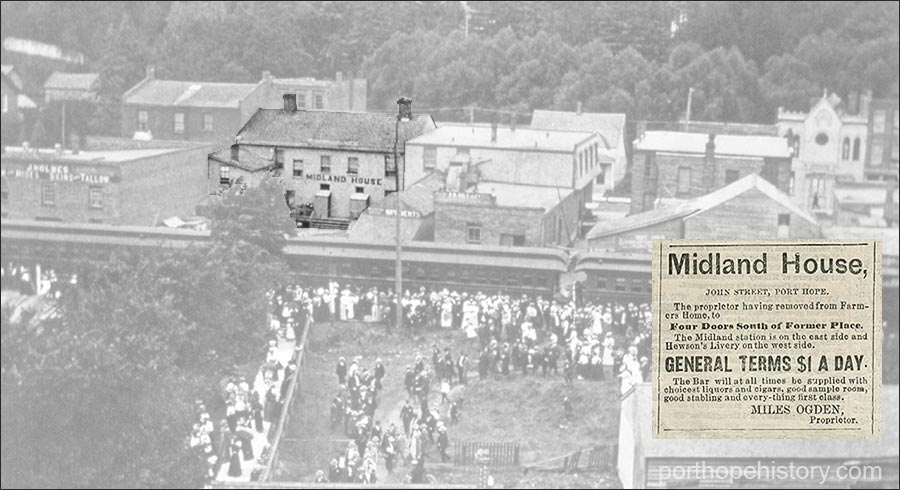
The furniture was almost all thrown out, but, although saved from fire, suffered severely from the rough handling it got. The fire this morning was a clear demonstration of the value of our waterworks; the brick building adjoining the hotel was uninjured. The hotel is owned by Mr. Wm. Garnett, Midland, and the loss is covered by an insurance of $1,000. Mr. Ogden was insured in the Royal Insurance Co. for $1,200. The Extinguisher and Chemical Companies, as usual, worked well this morning, but we didn't notice any from the Victorias, although the alarm bells, we believe, all rung.
from The Evening Guide July 27, 1959 page 8
METHODIST CHURCH
On Monday, July 31, 1893 the Methodist Church on Brown Street was discovered in flames, the origin was a complete mystery as there had been no fire about the building for several weeks.
It started near the cold air duct close to the main entrance and the draft of the stairway drew flames up to the tower. Smoke and water damage was about $3,000.
from The Evening Guide Monday July 27, 1959
The population of the settlement of Port Hope was 1517 when the Act of the Legislature was passed in 1834 to establish the limits of the town and elect a Board of Police as its governing body.
It had then a post office, customs office, shops, mills, four churches, breweries, a newspaper, eight distillaries, a market place but no town hall for President Marcus Whitehad and his Board to meet. They found space for conducting the affairs of the infant town wherever they could, sometimes in Strong's Coffee shop, or Thompson's Tavern, shifting from time to time.
On April 28th 1837 the Board formed themselves as a committee to superintend the construction of a town hall and market house at a cost not to exceed £1175 pounds sterling, the money to be borrowed, repayable in ten years. Nothing came of this however. Whether it was the interruption of the Rebellion of that year, or whether this body had not the power to borrow such an amount is not recorded.
In 1850 the Board of Police ceased to function. Under the new Municipal Act, Port Hope had become a town with a population of 2478 and a Mayor and Council were now elected. Among the first acts dealt with by Mayor W. T. Williams was the matter of constructing proper town offices.
In 1851 the contract was let to Philip Fox for a town hall to be constructed of bricks at a cost not to exceed $10,000. Before the building was completed, according to the Port Hope Guide Fyles, the cost had exceeded the estimates and the contractor was completely ruined. The cornerstone for this spacious building was laid by the Grand Lodge of Canada and the Officers of the A.F. & A.M. (Masonic). In 1855 the clock was added to the bell-tower at a cost of £144, (English) Sterling.
The building was adequate for its time not only as a place for conducting the public business but for much community enterprise. Lodge rooms were rented, Court was held, and at one time a Grammer school was conducted. In the basement, two rooms were set aside as a temporary gaol for overnight offenders.
This basement also accomodated the farmers who brought in the product of their farms to sell to the townspeople. The Guide reports prices at that time. Beef was sold by the quarter for $6.50, pork by the cwt. $6.00, apples $1.50 bushel, potatoes .30c bus., butter .15c lb., eggs winter prices, 18c doz. summer, 9c, winter wheat was $1.50 bus. and spring wheat, $1.35 bus.
At a meeting on March 1884 Councillor Ambrose proposed a scheme for remodelling the town hall with an addition, to be used as an Opera House. The cost to be $5000. His idea was for more revenue. Lodges occupying space paid only $60.00 per year, and were appealing for a reduction in rent to $40.00 a year. The proposal was laid over.
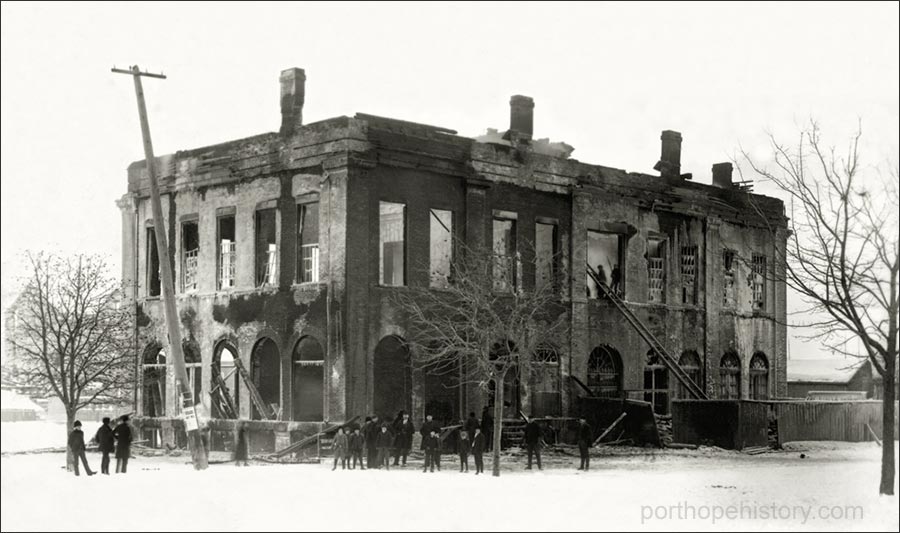
The Town Hall after the fire in February 1893
On the morning of Feb. 3rd, 1893 about 5 o'clock, fire was discovered by the caretaker and within a few hours the $20,000 building was in ruins.
The fire had started, according to caretaker John Gamble, underneath John Elliot's butcher shop. Gamble and his family occupied the south end over the lock-up. When he was awakened he rushed to release two tramps who had been placed in the lock-up for the night. Smoke drove him back from reaching the bell rope as the draught carried the flames up to the belfry, and soon all was ablaze. A heavy snow was falling which muffled the sound of the fire bell and when the brigade arrived they could only save the contents of the Mayor's office, the safe, and council chambers. The weather was so cold that the firemen were practically encased in ice.
Without a council chamber the next meeting of the town fathers took place over Major McLean's Music Store. H. V. Sanders who had served as town clerk for forty-one years was too ill to attend. Present were Mayor Burnham, Councillors White, Oke, Hansman, Rosevear, Cooper, McLean, Thompson and McMullen.
The most important business to come before them was clearing away the ruins. A resolution was passed to have a competent architect examine the foundations to see if they could be used, and to restore the old building as nearly as possible to duplicate the one destroyed.
The Trustees of the Methodist Church were asked to ring their church bell at the same time each day. The people of Port Hope had been accustomed to hearing the Town bell, at 7 am, 12 o'clock noon and 6 pm.
By April 18th the walls had been cleared and Architect J. W. Curry advised the Council to rebuild, since the foundations and walls had not been badly damaged. They were more substantial than most of the new buildings now going up.
J. W. Wallace tendered for the contract to reconstruct the town hall at a cost of $14,000. P. R. Randall applied for the position of Clerk of Works for the rebuilding, at a salary of $9.00 per week.
On February 26th 1894, the Guide reports the new bell was ringing from the new tower in the reconstructed Town Hall. Cost of the bell - $265, the clock was $785.00.
The Council had returned to their home.
DESTRUCTIVE FIRE
from a newspaper clipping March 3, 1916
That fine terrace of five houses on Baldwin street owned by Mr. W. R. Chislett is today a mass of charred wood. About 12:30 o'clock on Saturday afternoon smoke was noticed coming from the roof of the building and upon investigation it was found that the fire had gained considerable headway. An alarm was sent in and the firemen responded promptly and in the face of the extreme cold and high winds worked heroically. The building being covered by a tin roof made it extremely difficult to work, and Chief Ware instructed his men to work from the bottom. Fanned by the strong wind, the flames held sway and presently the roof caved in. This gave the firemen a better chance, and with four lines of hose they stuck to their posts and gradually had the blaze under control. Although the upper floor was completely ruined, the lower one braved the storm nobly and the greatest damage was due to water.
Two of the houses were occupied, one by Mr. Wm Davison and one by Mr. Claude Chislett. Through the energetic work of the firemen and soldiers a large amount of the furniture was carried out to safety, but the clothing and much of the upstair furnishings were lost.
The loss is estimated at $11,000, with insurance of $5,000 in the North British and Mercantile, The Scottish Union and the National.
The loss to the contents in Mr. Claude Chislett's residence is covered by insurance in the Pacific Coast.
Mr. W. R. Chislett, Mr. C. Chislett, and Mr. Davison are very grateful to the firemen, the soldiers and the citizens in general for the very valuable assistance rendered.
from a newspaper clipping December 3, 1945
EARLY MORNING FIRE AWAKENS GUESTS FORCES HURRIED EXIT FROM HOTEL
BUILDING DAMAGED NO ONE INJURED
A serious fire believed to have started from the furnace, according to Fire Chief Jack Record, broke out about 6:10 o'clock this morning at the Ontario Hotel, Ontario St.
Fortunately the proprietor, Mr. Powell, his wife, and an employee N. E. Sherrard were in the kitchen, and noticed smoke seeping up through the floor. They immediately aroused the some thirty odd guests who were sleeping at the time, and then turned in the alarm for the fire department, which was responded to in record time. A double alarm was sounded on the siren because of the nature of the building.
The guests grabbed their clothes and rushed to the street. However, so far as is known no person was injured.
The firemen under the leadership of Chief John Record, upon arriving on the scene fought a stubborn blaze mostly hidden in the walls for two hours before subduing it. They managed however, to confine it to the north wing where the damage was considerable. The floor in the men's beverage room was torn up, and the fire, travelling up through the walls, broke out into the bedrooms on the two floors above.
Mr. Powell, in an interview this morning, following the disaster, said, that he could not be too strong in his praise of the exceptionally fine work of the local fire department. They took caree in fighting the fire to preserve as much of the furnishings as possible.
Oldtimers will remember the establishment as being one of the landmarks in Port Hope. One elderly gentleman was heard to exclaim this morning, that he was eighty years young today, and could remember it as a going concern in his early childhood. Fifty years ago the hostelry was known as the Bennett House.
The hotel is believed to be covered by insurance.
The local police, represented by Constable Carr were on the job from the beginning and directed the traffic which was complicated by the icy conditions of the roads.
Use the form below to comment on this article. A name is required, optional email addresses will not be revealed.